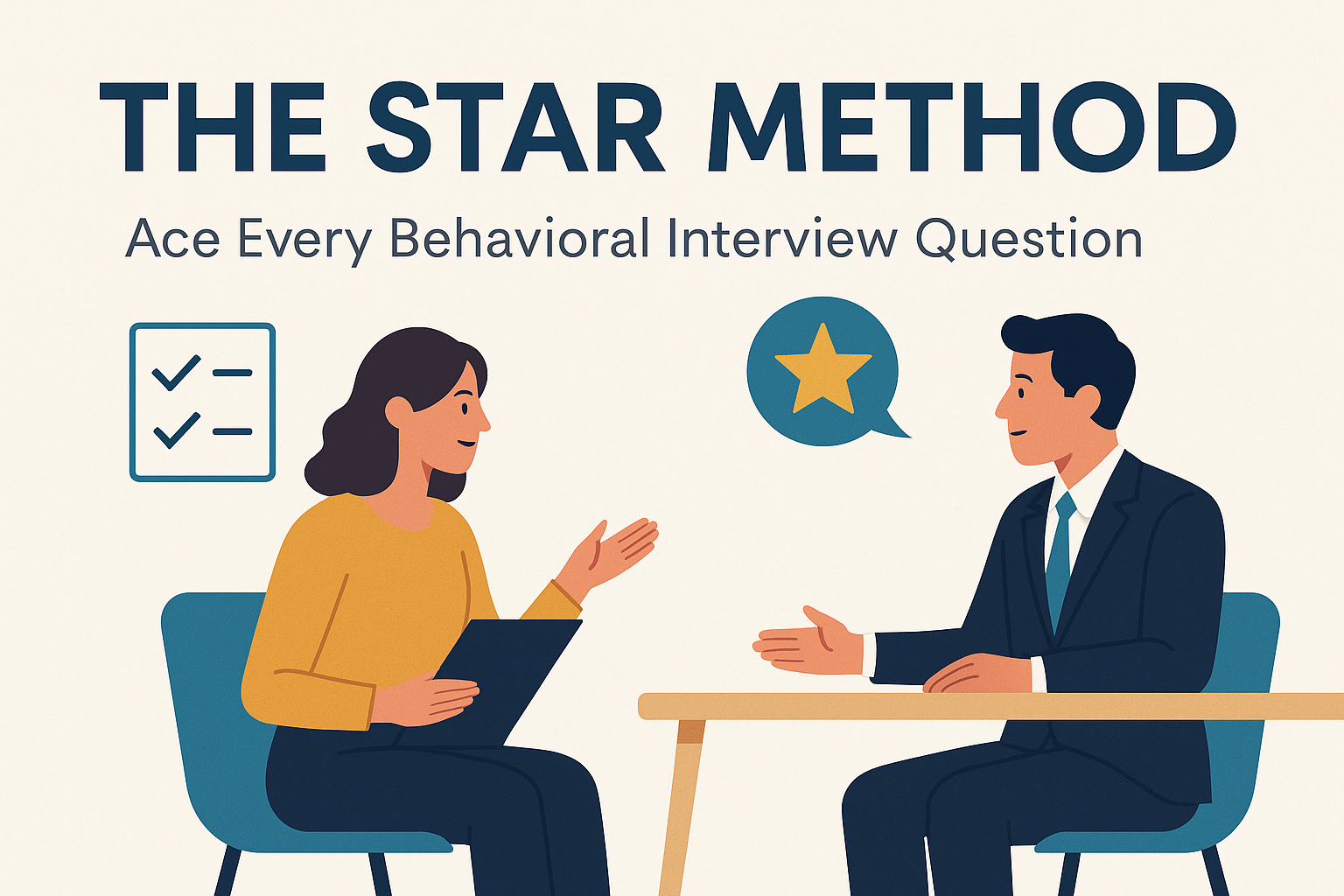The STAR Method: Ace Every Behavioral Interview Question

Ever been in a job interview and asked, “Tell me about a time when you handled a difficult situation”? These are behavioral interview questions, and they’re not just meant to stump you—they’re designed to evaluate how you think, act, and solve problems based on past experiences.
To ace these questions, hiring managers don’t want vague answers. They want clarity, structure, and real-world proof of your skills. That’s where the STAR method comes in.
This blog walks you through how to use the STAR technique to answer any behavioral interview question with confidence. We’ll include examples, a real-life case study, and tools to help you prepare.
1. What Is the STAR Method?
S.T.A.R. stands for:
- Situation: Set the context.
- Task: Explain your responsibility.
- Action: Describe the specific steps you took.
- Result: Share the outcome or impact.
This structure keeps your answer focused and compelling while avoiding rambling or going off-topic.
2. Why Interviewers Use Behavioral Questions
Behavioral questions aim to predict future performance by understanding how you handled situations in the past. Employers use them to assess:
- Problem-solving skills
- Leadership and teamwork
- Time management
- Conflict resolution
- Adaptability and resilience
Examples include:
- “Tell me about a time you failed and how you handled it.”
- “Give an example of a time you worked in a team.”
- “Describe a situation where you had to meet a tight deadline.”
3. How to Prepare for STAR Interviews
Step 1: List out the competencies required for the job. (Check the job description.)
Step 2: For each competency, recall one or two past experiences.
Step 3: Write out STAR responses for each story using the four steps.
Tool: Use Google Docs, Notion, or a free STAR worksheet like this to organize responses.
4. Breaking Down the STAR Format
Let’s dive into each part:
S = Situation
- Set the scene. Keep it short and relevant.
- Example: "At my previous job, our client was unhappy with our delayed project deliverables."
T = Task
- Explain what you needed to accomplish.
- Example: "I was responsible for re-aligning the team to meet the new deadline and improve client satisfaction."
A = Action
- Describe what you specifically did, not your team.
- Example: "I created a new project timeline, held daily check-ins, and re-distributed tasks to improve efficiency."
R = Result
- End with the outcome and, if possible, quantify it.
- Example: "The project finished two weeks early, and client satisfaction rose from 60% to 92% in post-delivery feedback."
5. Sample STAR Interview Answers
Q: Tell me about a time you had to deal with a conflict at work.
Answer:
S: In my role as a team lead at a digital agency, two team members had a disagreement about design directions.
T: My responsibility was to ensure the project stayed on track while resolving the conflict.
A: I scheduled a one-on-one with each person, then brought them together to facilitate a brainstorming session. I helped them find common ground and agree on the core message of the design.
R: We finalized the design within the deadline, and both team members later collaborated on another successful campaign.
6. Tailor STAR Responses to Different Roles
For leadership roles: Emphasize strategic thinking, delegation, and impact. For entry-level: Focus on school projects, internships, or volunteer experiences. For tech roles: Highlight problem-solving, coding projects, and team contributions. For customer-facing roles: Show empathy, service mindset, and problem resolution.
7. Common STAR Interview Questions by Category
Teamwork:
- Tell me about a time you worked in a group.
- Describe a project where you had to collaborate with cross-functional teams.
Problem-Solving:
- Describe a time you faced an unexpected challenge.
- Tell me about a tough decision you made.
Conflict Resolution:
- Tell me about a time you disagreed with a coworker or supervisor.
Leadership:
- Describe a situation where you led a team.
- Tell me about a time you motivated others.
Time Management:
- How do you prioritize multiple deadlines?
- Tell me about a time you had to manage competing tasks.
8. Tips for Polishing STAR Responses
- Keep answers under 2 minutes
- Don’t get lost in backstory
- Avoid speaking in generalities
- Practice aloud or with a friend
- Record yourself using apps like Loom
9. What to Avoid When Using STAR
- Too much detail (Keep it concise)
- Taking all the credit (Acknowledge team if applicable)
- Focusing on failure without a lesson
- Generic outcomes (Be specific and measurable)
10. Case Study: Ravi’s Journey to Landing a Data Analyst Role
Ravi, a 26-year-old in the UK, was transitioning from a customer support role into data analytics. He struggled with interviews because he lacked formal experience.
A mentor introduced him to the STAR method. Ravi:
- Prepared 6 STAR stories from past work, courses, and volunteer experiences
- Focused on transferrable skills: problem-solving, Excel analysis, and communication
- Practiced answers using mock interviews on Pramp
One of his STAR responses:
S: During my online data course, I noticed inconsistencies in the sample dataset.
T: I wanted to clean the data to ensure accurate analysis for our final project.
A: I used Excel and Power Query to remove duplicates, correct date formats, and identify outliers.
R: Our final analysis was praised by the instructor, and our group received the highest score.
Result? Ravi landed a junior data analyst job at a healthcare startup.
Takeaway: STAR stories aren’t limited to formal jobs. Any structured, thoughtful experience can count.
Tools and Templates for STAR Interview Prep
Interviews can be nerve-wracking, but STAR turns chaos into clarity.
With the STAR method:
- You avoid rambling
- You stay focused on outcomes
- You tell memorable stories that showcase your real value
Prepare 5–7 solid STAR stories and practice them regularly. Soon, you’ll find behavioral interviews become less intimidating and more like conversations.
Subscribe to UJ+ for expert job search content, real stories, and smart career strategies delivered weekly.

